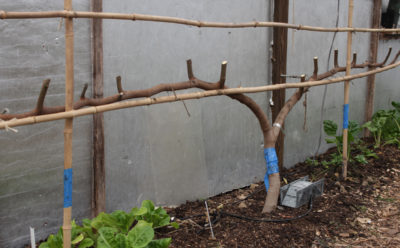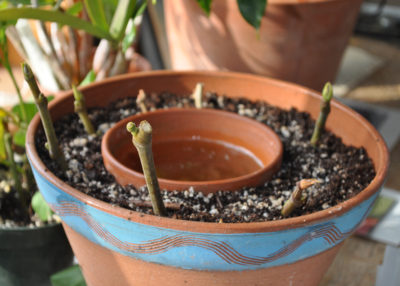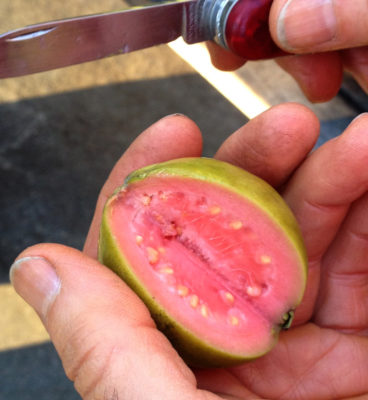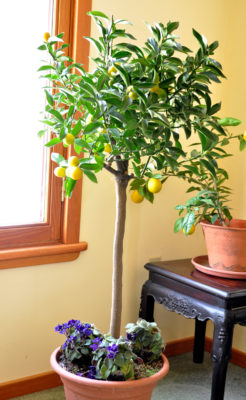GARDEN DREAMS AND REALITY
Figs (Cuttings) Galore!!
Cold weather and short days have put a not totally unwelcome lull in the gardening year. Nonetheless, I wander into the greenhouse occasionally just to drink in the sight and smell of lush greenery suffused in warmth and humidity, and to pull some weeds. The figs in there could use some pruning; they are dormant and leafless and need all stems cut back to 3 to 4 feet in height.
Gardening lull or not, I can’t just toss those cut stems away, putting them to waste. Each stem can make a whole new tree, and fairly easily. So I set up a little propagator for rooting some of these “hardwood cuttings.”
Being leafless, the cuttings lose little water so have no need for the high humidity demanded by softwood cuttings, which are cuttings taken while plants are actively growing and leafy. Any cutting, hardwood or softwood, does need its bottom portion, where roots will form, cozied in moisture and air. Some people just plop stems into a glass of water. That works for easy-to-root plants, like fig, as long as the water is occasionally changed so bacteria don’t build up and the roots get some oxygen from the freshly drawn water. Roots formed in water are morphologically different from those in soil, so the eventual and inevitable transfer to soil must be done with care, with attention to root breakage, aeration, and moisture.
My cuttings will root directly in soil, or a “soil” of some sort, actually a soil-less soil similar in makeup to most commercial potting mixes. This soil is nothing more than a mix of equal parts perlite, a “popped” volcanic rock, and peat moss. The perlite is for aeration; the peat moss is to hold moisture. (Coir, a byproduct of the coconut industry, or leaf mold could be substituted for the peat moss.)
Now here’s the cool part: After filling a large flowerpot with the rooting mix, I scooped out the center and put into the hole a smaller flowerpot. That smaller flowerpot has to be terra cotta and unglazed. It also needs it’s drainage hole plugged; some moldable wax, saved from when my daughter had braces, worked well. (I knew I had saved that wax all these years for something!) Rapping the large pot and pressing lightly on the soil ensured good contact and a continuous capillary connection between the water in the inner pot, the porous wall of the pot, and the surrounding soil.
I slid the cuttings into the circle of soil with only one or two upper buds showing. Until leaves appear, and there’s no rush, the only attention the pot needs is to keep the inner reservoir of soil filled with water. Once leaves appear, the cuttings need light.
Sometime I’ll have to figure out what to do with all my new fig plants.
A Dream Breaks The Lull
New plants in the wings could have been the spark for a horticultural dream the night following setting up the propagator. In this dream, I lived in a large, modernistic house, the most significant features of which were its 3 stories and large, south-facing windows. I evidently wasn’t all that familiar with the house because I wandered around in amazement.
Most amazing were the plants sitting in the windows: potted fruit plants of all sorts, everywhere I turned. In one window was a potted pawpaw tree, in another a peach, then a guava, and still other fruits in other windows. Turning to go down the stairway from the uppermost floor, I came upon small pots of strawberries. (The floors themselves were broad expanses of polished wood and furniture was sparse or absent.)

Strawberry guava
Most amazing was the shadow of a lush plant hanging in front of a shaded window. Coming closer, I saw that the plant in the hanging basket was a grape vine, a compact-growing one and that was loaded with tight bunches of delicious, ripe grapes.
Much of the dream is not far-fetched. True, I don’t live in a large, modernistic house of 3 stories. But some of my windows are, in fact, home to such edibles as bay laurel and rosemary. I even have some fruiting plants, tropical and subtropical ones such as Meiwa kumquat and Golden Nugget tangerine rather than pawpaw, grape, and other temperate-zone plants that need to experience winter.
A strawberry guava I once grew gave me good harvest in late autumn. Kumquats ripen in early winter. I look forward to my first tangerine and Meyer lemon harvest. Fruiting takes energy, so all these fruit plants sit near sunny windows. Indoor fruiting by a shaded window only works in dreamland.
Awake, Finally
In that same dream, I was in school. (I spent an inordinate number of years in school.) In the dream, I couldn’t keep track of my school assignments, even what classes I was taking or where. I was too preoccupied with caring for all those plants in all those windows at home.
It was good to wake up to a gardening lull.



The blue wrapping on bamboo and fig is to warn someone not to cut? Does your greenhouse move like Eliot Coleman or is it stationary? I think the latter if I remember correctly
No, the blue wrap was painters tape coated with Tangletrap to keep ants from climbing up into the tree and helping scale insects. My greenhouse is stationary.
Can you make some sketches of this dream house? Sounds great. I might build it if you can share some tips. How do the windows retain heat in the winter? Would you put small screened windows above the big glass ones to vent in the summer? Just the other week at work during downtime I was trying to figure out how to connect a dream for a Canadian style timberframe with interior log stack walls with a modern 2 or 3 story (possibly masonry) with massive south facing windows…. with a connected sliding glass greenhouse like I saw on a video where a tv show went to Barbara Damrosch and Eliot Coleman’s home. I even thought about building in to a hillside to get the 3 stories of southern windows.
My dream house was a house I imagined in a dream — not a “dream hose” in the usual sense. The house in my dream wasn’t necessarily realizable or practical; it was a dream.
Will BT-I dunks clog the porousness of the terra cotta?
My guess is “no,” bt I’ve never sed the dunks.
The dunks kill mosquitos – natural larvacide. Great for any standing water.
Yeh, I know. I just have never used them.
may I ask if you can possibly mail me a few fig cuttings ? I have been looking around locally in New York area.
I don’t have any left.
Thanks for your reply.